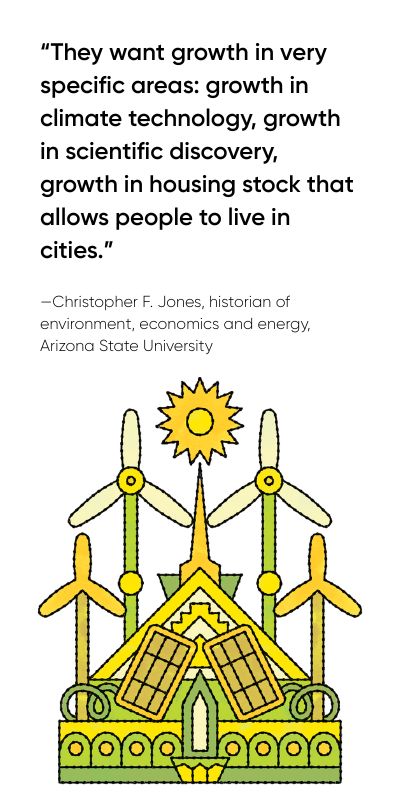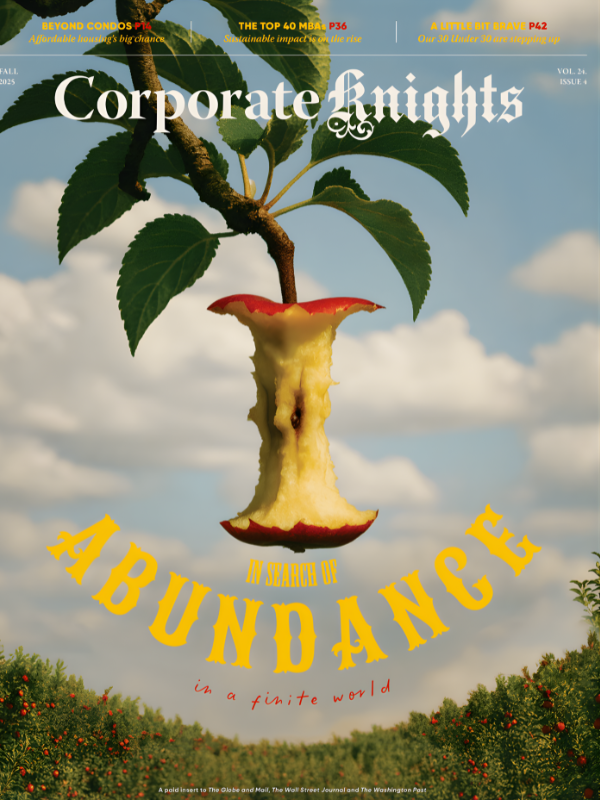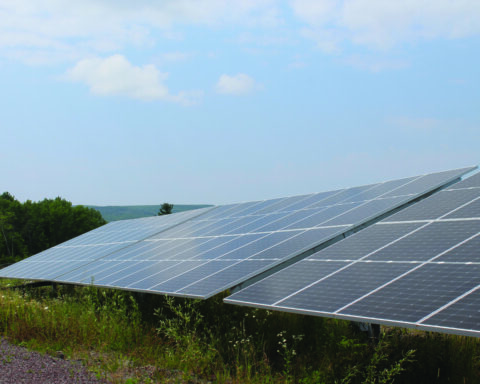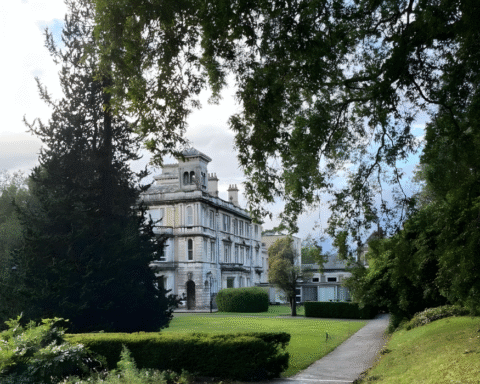What would the economy look like if governments trimmed back bureaucracy to let innovators innovate? The opening pages of Abundance: How We Build a Better Future paint one vision. Authors Ezra Klein and Derek Thompson envision a Jetson-esque future: clean energy, lab-grown meat, new medical advancements, less time spent working, more time enjoying cheaper, eco-friendly intercity travel. The life described in the book is like today’s but run through an Instagram filter that shows a more bountiful world, and one that’s further down the green-energy-transition pathway.
If you haven’t heard about abundance yet, you probably will. The concept is having a moment and shaping policy discussions in North America and around the world. Titles like Klein and Thompson’s, Yoni Appelbaum’s Stuck and Marc Dunkelman’s Why Nothing Works all make versions of the same case.
Abundance is starting to step off the bookstore shelf, igniting policy discussion forums at think tanks and universities. In September, more than 120 U.S. local politicians formed Abundance Elected to mould future local political leaders in the concept’s image.
 Listen to any podcasts discussing abundance (themselves abundant) and critical realities are often glossed over. Innovations rarely take hold overnight, and some big swings will spectacularly fail. Abundance is often inscrutably clouded in start-up speak and the dynamic postures and sky’s-the-limit potential of aspiring Elon Musks pitching to venture capitalists. Financial speculators can take a punt on whatever risky start-up they want; it’s their dime. But for reimagining society, politicians and business leaders need to focus on concrete issues, not vibes. It is necessary to sell the sizzle and the lab-grown steak.
Listen to any podcasts discussing abundance (themselves abundant) and critical realities are often glossed over. Innovations rarely take hold overnight, and some big swings will spectacularly fail. Abundance is often inscrutably clouded in start-up speak and the dynamic postures and sky’s-the-limit potential of aspiring Elon Musks pitching to venture capitalists. Financial speculators can take a punt on whatever risky start-up they want; it’s their dime. But for reimagining society, politicians and business leaders need to focus on concrete issues, not vibes. It is necessary to sell the sizzle and the lab-grown steak.
Abundance proponents suggest that a sizable amount of the scarcity we live with is born of assessments, bureaucratic processes and regulations. For example, the International Energy Agency estimates that around 1,650 gigawatts of clean energy capacity in advanced development stages is waiting to be connected to the grid. By reducing barriers, we can spur innovation, fight climate change, grow the economy and live our best lives.
Though abundance is a more-is-more policy, the growth it inspires is not indiscriminate. “They want growth in very specific areas: growth in climate technology, growth in scientific discovery, growth in housing stock that allows people to live in cities,” says Christopher F. Jones, a historian of environment, economics and energy at Arizona State University. Though Jones disagrees with some of the key arguments the book makes, he says this focus makes abundance “different and more subtle” than simply chasing gross domestic product.
While talking heads sell abundance as new, in some respects it’s not radically different from the economic system we already have. Abundance is pro-business, friendly to entrepreneurs and new entrants, and it doesn’t sideline traditional metrics like GDP growth and job creation. It is a maximalist creed that caters to desires people have for the latest tech and enjoying lives of leisure, if we can step out of our own way.
In their telling, scientists, clean energy companies and real estate developers are sitting idle like cars at a red light, waiting for it to turn green so they can solve problems like illness, climate change and scarce housing. One example is the COVID-19 vaccine. Creating a working vaccine in short order required the U.S. government to launch Operation Warp Speed (OWS), reducing red tape for drug approval, investing in research, and collaborating with corporate America to get jabs in arms. Klein and Thompson point to the speed and effectiveness of OWS as an example of what abundance-style thinking leads to.
The crises spread plainly before us – climate and housing especially – add urgency to this narrative. “We either build faster or accept catastrophe,” they write.
Fewer restrictions, more big swings
In Canada, we build slow. In a recent podcast appearance, Prime Minister Mark Carney advocated changing the federal government’s approach to green-lighting and regulation, shifting “from why to how” when it comes to major projects. For example, it’s not unheard of for projects facing federal environmental assessments such as interprovincial transmission lines, hydropower or railways to expect the process to take years. And a review from Blakes law firm says the climate of environmental regulations in Canada is growing stricter, rather than more relaxed. Meanwhile, Europe is dramatically simplifying its climate reporting standards for companies to boost competitiveness.
According to the abundance crowd, the reflex to keep tightening environmental rules has become an anachronism. As the toll of our activities on the planet shocked the public in the 1960s and 1970s and led them to demand change from those in power, the price for building green became building slowly. It served us then, but boosters of abundance suggest these regulations now prevent us from building and innovating enough, and the costs and time delays have become if not discouraging, prohibitive. With fewer restrictions and more big swings, the growth we realize, in theory, could go on forever.
Yet keeping lifestyles robust and expanding the economy – even with pure and green aims – is at odds with the more penitent, scaled-back approach that critics say the climate and ecological crises demand.
Consider the expected growth of AI use, powered by electricity-intensive data centres. The World Economic Forum estimates that globally such centres will use more power than Japan by 2030. An abundance argument doesn’t demand a societal pivot away from AI tech, or disincentivize the industry – it switches it to green energy, so we can have our cake and eat it too. At least to a certain point.
“When confronting the reality of infinite growth and resource consumption on a finite planet, they resort to hand-waving it away via techno-optimism: the belief that new technologies will overcome resource constraints,” says Matt Orsagh, co-founder of the Arketa Institute for Post-Growth Finance.
If abundance’s central problem is society not flexing its innovation muscles enough, there’s another critical dilemma alongside it. Have we pushed the limits of our ecosystem too far with pollutants and resource extraction, and if not, how much further can we morally and physically go?
Who benefits?
 Abundance harkens to David Potter’s mid-20th-century “people of plenty” concept, which suggested that Americans defined themselves by the economic abundance that shaped their lives and coloured national character after the Second World War. It ushered in a new prosperity for many, in those less regulated days, even if key ingredients in examples of the time included exploitative practices (like extensive rail lines built using poorly paid immigrant labour) today’s society wouldn’t accept.
Abundance harkens to David Potter’s mid-20th-century “people of plenty” concept, which suggested that Americans defined themselves by the economic abundance that shaped their lives and coloured national character after the Second World War. It ushered in a new prosperity for many, in those less regulated days, even if key ingredients in examples of the time included exploitative practices (like extensive rail lines built using poorly paid immigrant labour) today’s society wouldn’t accept.
Abundance proponents suggest we can all benefit under a wide economic umbrella. But Jones says that Klein and Thompson focus too much on urban audiences in Abundance and that policies that concentrate too keenly on cities might leave behind low- and middle-income rural residents. Omer Tayyab, an ecological economist at the University of Barcelona’s Institute of Environmental Science and Technology, notes that the United States is already a wealthy country per capita yet chooses not to distribute the wealth. “Having a more deregulated system, even if it were to produce more, wouldn’t necessarily mean that the most vulnerable are uplifted,” he says.
Then there is the trust question. In an abundance society, political leaders will decide where to focus deregulation and growth opportunities. Business people will choose how to innovate in ways that make society more plentiful, which may not always bless their bottom lines. Yet we’re in an era unconducive to trusting these groups to reform in the best interests of the hoi polloi. Earlier this year, Angus Reid polled liberal and conservative Canadians to see what groups they trusted. Both overwhelmingly have a “great deal or fair amount of trust” in scientists. Political leaders, big businesses and large tech companies scored low.
Rebuilding public trust will be critical to chasing an abundance agenda in the United States. Recent polling suggests Democrats respond more favourably to populist rather than abundance-coded messages.
Mark Carney: Abundance bro?
Abundance policy offerings are scarce in Canada. Provincial governments in Alberta and Ontario have successfully won mandates with promises to trim red tape, but fixes have mostly been small, mundane bureaucratic processes rather than at-scale fixes to unlock abundance. Tariff threats, lagging productivity and failure to commercialize innovation make abundance a timely concern.
Canada’s 2025 election polls showed that Canadians were worried about the country’s relationship with the United States, housing affordability and cost of living. Abundance policies align with these concerns, but the connection has to be explicitly drawn by lawmakers.

As a centrist liberal politician, Mark Carney aligns ideologically with the dominant view of abundance circulating in society. But suggestions from columnists and other wonks that he is an abundance politician conflates abundance with willingness to build. Case in point: Build Canada Homes. The new federal entity has a goal of increasing home construction in Canada, and Liberals have promoted it using abundance language. Carney recently announced initial funding of $13 billion and the construction of 4,000 new homes on six sites across the country.
But abundance is meant to unleash tools we have at the ready. The goals of Build Canada Homes, though promoted in abundance-speak, are heavily predicated on advanced prefab technology that isn’t at scale yet, plus Canada lacks the construction workforce to build this influx of homes.
Mike Moffatt, an economist with the Missing Middle Initiative, points to the Federal Housing Accelerator fund as another example of abundance-flavoured policymaking to address the housing crisis. The $4.4-billion purse is directed at helping municipalities increase housing stock faster, tying approval to outcomes like increasing density and growing supply faster than historical averages. What separates it from status quo thinking is not only the big vision, but a program designed to outpace current expectations for housing growth and the willingness to change regulatory habits to make it happen.
It’s too early to tell if the abundance movement will take itself, as one advocacy group puts it, “from op-eds to outcomes.” But interesting times call for solutions that meet the moment. Our culture of regulation has led to a point where many feel society is stagnant and regulations are preventing us from thriving. Abundance represents a clear break from this history. If making inroads on housing, climate change and more bountiful lives is really only a matter of turning red lights to green, perhaps it’s time to finally start making the switch.
Rob Csernyik is a freelance journalist specializing in business and investigative reporting, as well as long-form features.
The Weekly Roundup
Get all our stories in one place, every Wednesday at noon EST.







